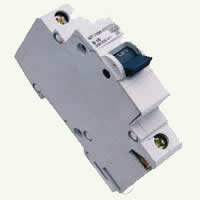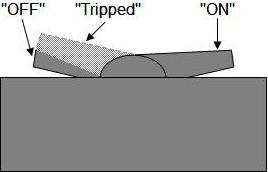
Figure 1 - Single pole circuit breaker
A circuit breaker will trip (turn itself OFF
) for one of two reasons:
- There is an overload or short on the circuit. This is the purpose of having a circuit breaker. If a circuit breaker, as shown in Figure 1, senses a load that is in excess of its current carrying capabilities it will protect the wiring from overheating and possible causing a fire, by turning itself
OFF
.
This problem is usually identified in having the breaker turn itself OFF
when an electrical device is turned on. Most of the 15 amp circuits in a home carry more than one device or have the ability to carry more than one device. As an example, each electrical receptacle does not have its own circuit breaker associated with it. In newer homes, refrigerators and microwaves will have dedicated breakers, however in older homes this is definitely not the case.

Figure 2 - Positions of circuit breaker lever
Note: A circuit breaker that has tripped, does not go all the way to the OFF
position. The lever on the circuit breaker will go to a point that is about 10% from the OFF
position. In many cases it is difficult to visually see the difference between a circuit breaker that has tripped and a circuit breaker that is OFF
, as shown in Figure 2. When resetting a circuit breaker it is often necessary to move the lever to the full OFF
position before turning it to the ON
position.
Breakers will trip if older appliances become defective in a manner that causes a higher current to flow. However, problems of overload can be caused by the simple act of replacing a group of 40 watt bulbs with 60 watt bulbs.
Determining The Location Of The Overload Or Short Circuit:
- Turn off all light switches that are on the circuit that is experiencing the problem.
- Unplug all appliances and other electrical that are on the circuit that has the tripping circuit breaker.
- Reset the circuit breaker to the
ON
position. - If the circuit breaker does not trip then begin to turn light switches to the
ON
position one at a time. If any of the light switches cause the circuit breaker to trip, you have identified the section of the circuit that is causing the problem. The problem could be a short in an electrical box, a defective switch, defective light fixture or in the wiring from the switch to the light fixture. - If you can turn all of the lights on without the circuit breaker blowing, commence plugging in the appliances or other electrical devices that were on the circuit when the circuit breaker tripped. The appliances and other electrical devices should have there
ON
/OFF
switches in theOFF
position. - If you have all the lights on and all of the appliances and electrical devices plugged in and the circuit breaker has not tripped you should start turning
ON
each of the appliances and electrical devices. Turn the appliance or electrical deviceON
, wait 5 seconds and if it doesn't trip the circuit breaker turn itOFF
and do the same with the next appliance or electrical device.
If the circuit breaker continues to trip with all the light switches in the OFF
position and without any appliances or other electrical devices plugged into the circuit the problem is in the wiring, a switch, an electrical receptacle (outlet) or you have a defective circuit breaker (see item 2).
Note: One of the most common circumstances that cause breakers to trip are nails or screws that have shorted out wires inside a wall. This can happen when hanging items on a wall, such as kitchen cabinets or other items that require long fasteners. If your problem with a tripping circuit breaker started after doing some renovations, having a fastener that is shorting a wire could easily be the problem.
If when you plug an appliance or other electrical device into the electrical receptacle and the circuit breaker trips the problem is either a defective electrical receptacle (outlet) or a defective cord or plug on that specific appliance or electrical device.
Additional information on replacing an electrical receptacle (outlet).
Note: If any of the appliances have electrical heating coils, such as a toaster, coffee pot or griddle, wait 30 seconds before turning the appliance OFF
.
If any of the appliances or electrical devices trip the circuit breaker when that appliance or electrical device's power is in the ON
position, you have a defective appliance or electrical device.
